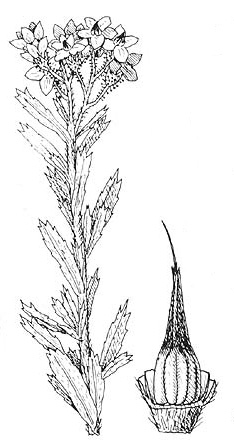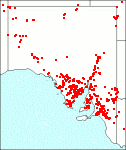Family: Boraginaceae
Halgania cyanea
Citation:
Lindley, Sketch Veg. Swan Riv. Col. 40 (1840).
Synonymy: H. strigosa Schldl., Linnaea 20:614 (1847).
Common name: Rough halgania, mallee blue-flower.
Description:
Perennial shrubs to 60 cm high, much-branched, more or less densely covered with double-ended appressed hairs as well as stalked glandular hairs soon wearing off the stems; leaves usually sessile, entire to more or less toothed, usually oblanceolate to narrowly wedge-shaped or linear-elliptic, 0.4-2.5 x 0.2-0.5 cm, acute, obtuse or truncate, flat or folded lengthwise and more or less convex below, covered with appressed double-ended hairs.
Inflorescence a terminal thyrse with 1-5 monochasia each with 1-3 flowers or rarely more, with bracts usually at the base, with pedicels 2-12 mm long; sepals connate in the lower third or to half their length, equal, linear-triangular to lanceolate, 3-4 mm long and scarcely elongating after flowering, acute to obtuse; corolla rotate, usually bright-blue, with few double-ended hairs outside, 5-8 mm long, with lobes ovate to lanceolate; stamens with free filaments c. 1 mm long, inserted in the throat of the corolla tube, with anthers exposed in an erect column around the style, narrowly ovoid, c. 2 mm long with a terminal appendage, 1.5-3 mm long, stiffly erect, hairy and particularly with hooked hairs on the inside; ovary conical to almost cylindrical, rounded and with a terminal style, 5-8 mm long, with an insignificant terminal stigma.
fruit indehiscent, drupaceous, with 1 or 2 seeds, brown.

| Flowering branch and flower with calyx and corolla removed.
|
Image source: fig. 537B in Jessop J.P. & Toelken H.R. (Ed.) 1986. Flora of South Australia (4th edn).
|
Published illustration:
Cunningham et al. (1982) Plants of western New South Wales, p. 567.
|
|
Distribution:
|
S.Aust.: NW, LE, NU, GT, FR, EA, EP, NL, MU, YP, SL, SE. W.Aust.; N.T.; Qld; N.S.W.; Vic.
|
Conservation status:
native
Flowering time: June — Dec., but some flowers are often found at other times.
|

SA Distribution Map based
on current data relating to
specimens held in the
State Herbarium of South Australia
|
Biology:
No text
Taxonomic notes:
A complex species which shows a wide range of variation with different ecological conditions, juvenile leaves are usually different from adult ones and the following local variants are noteworthy: 1. In the regions NU and northern EP all the leaves tend to be wedge-shaped with a truncate apex with few teeth. The glands on the pedicels are sessile or almost so and the calyx lobes are about as long as the tube. 2. In the north-eastern EP to NL plants with almost linear, entire leaves arc often found and they have usually relatively long appendages to the anthers (cf. H. erecta). 3. Plants from the northern FR and LE regions tend to have serrate leaves and they are usually densely covered with stalked glands. The anthers usually have relatively long appendages. H. preissiana Lehm. included by J. Black in the synonomy is now recognised as an independent W.Aust. species without glands on leaves and stems.
Author:
Not yet available
|

